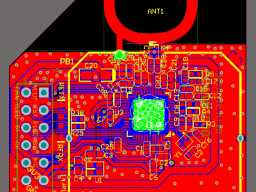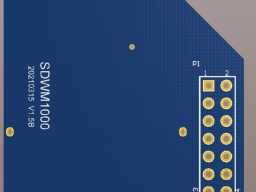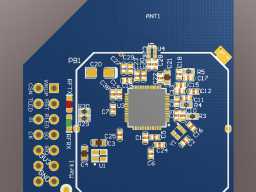Home
UWB Location Dual Network Port Outdoor Anchor A1108 Baseboard Circuit Diagram and PCB Diagram - Price: $300
- Details
- Written by: zhang
- Category: Selling
UWB Location Dual Network Port Outdoor Anchor A1108 Baseboard Circuit Diagram and PCB Diagram - Price: $300
A1108 is based on the dual network port anchor A1106P. It adds a high-brightness LED light according to the characteristics of the outdoor environment.
Like the A1106P, there are network switch chips and POE power supply chips, which can connect multiple anchors in a series to save wiring costs and POE switch ports.
Use STM32F103RET6 as the main control MCU, W5500 as the network interface, TPS23753APW as the POE power receiver, MAX5980 as the POE power supply chip, and IP175 network switch chip.
Please note that only AD project files are provided, and there is no STM32 firmware source code. If you need the firmware source code, please click here: UWB Location Anchor Firmware Source Code - Price: $7,500 USD
Please note that only the circuit and PCB of the outdoor anchor backboard are included, and the circuit of the UWB module is not included. Because the original UWB module DWM1000 uses a ceramic antenna, it cannot be used outdoors. The outdoor version of the anchor can only use external antennas. Therefore, either the DWM1000 module is modified and an SMA socket is installed, or another UWB module is designed. We have an external antenna version of the UWB module, please click here: UWB Module UM2000 Circuit Diagram and PCB - Price: $450 USD
We provide the following 3 versions of AD project files:
├─AnchorV-Outside V1.0
│ ├─pcb
│ └─sch
├─AnchorV-Outside V1.2-OK
│ ├─pcb
│ └─sch
├─AnchorV-Outside V1.3
├─pcb
└─sch
UWB Module SDWM1000 Circuit Diagram and PCB - Price: $300 USD
- Details
- Written by: zhang
- Category: Selling
UWB Module SDWM1000 Circuit Diagram and PCB - Price: $300 USD
This is our later mass production module. The module uses a PCB antenna and uses pin headers to connect to the anchor chassis. Can be directly adapted to two models of indoor anchors, A1102P and A1106P.
This module has basically the same circuit as the original DWM1000 and has no extra functions. Please note that LNA and PA are not added .
We have tested that when using 850K rate, the longest communication distance is about 200 meters to 300 meters .
Someone may wonder why the module circuit is more expensive than the anchor backboard circuit?
Because of the difficulty! Hardware engineers know that in most cases, digital circuits are simpler than analog circuits.
Although we have modified the chassis of the single network port anchor dozens of times, the changes are all in details. It cannot be said to be worthless, but it is not strictly necessary.
In the early days, in order to reduce the difficulty of research and development, we always used the original UWB module. As the product matured and we hoped to reduce production costs, we decided to develop our own UWB module. The difficulty in developing UWB modules mainly lies in wiring. The wiring of the RF circuit is not just about impedance matching. This has always been a technical job, which requires not only theoretical support but also empirical support. We tried it many times before we got a satisfactory result. You can think about it, how long does it take a qualified engineer who is proficient in RF wiring to figure this thing out? How much salary are you going to pay him? For this price, it's just free of charge.
If you need a module with longer communication distance, please click here: UWB Module UM2000 Circuit Diagram and PCB - Price: $450 USD or UWB Module Anchor-RFM-PA-LNA-ANT Circuit Diagram and PCB - Price: $450 USD
UWB Location Dual Network Port Anchor A1106P BackBoard Circuit Diagram and PCB Diagram - Price: $300 USD
- Details
- Written by: zhang
- Category: Selling
UWB Location Dual Network Port Anchor A1106P BackBoard Circuit Diagram and PCB Diagram - Price: $300 USD
A1106P is based on our best-selling anchor A1102P, which adds a network switch chip and a POE power supply chip. It can connect multiple anchors in series to save wiring costs and POE switch ports.
Use STM32F103RET6 as the main control MCU, W5500 as the network interface, TPS23753APW as the POE power receiver, MAX5980 as the POE power supply chip, and IP175 network switch chip.
Please note that only AD project files are provided, and there is no STM32 firmware source code. If you need the firmware source code, please click here: UWB Location Anchor Firmware Source Code - Price: $7,500 USD
We provide the following 6 versions of AD project files:
├─SCH-AnchorV-POE V3.0-打样
│ ├─pcb
│ └─sch
├─SCH-AnchorV-POE V3.1-打样
│ ├─pcb
│ └─sch
├─SCH-AnchorV-POE V3.2-打样
│ ├─pcb
│ └─sch
├─SCH-AnchorV-POE V3.3-量产一次
│ ├─pcb
│ └─sch
├─SCH-AnchorV-POE V3.4(TI-UWB原厂模块,仅打样)
│ ├─pcb
│ └─sch
└─SCH-AnchorV-POE V3.5-批量量产
├─pcb
└─sch
Please note that this sales item only includes the anchor backboard and does not include UWB module circuits. If you use the original DWM1000 module, we can provide the adapter board PCB diagram.
If you want to produce UWB modules by yourself, we have 3 types of UWB modules for you to choose from.
UWB Module SDWM1000 Circuit Diagram and PCB - Price: $300 USD
UWB Module Anchor-RFM-PA-LNA-ANT Circuit Diagram and PCB - Price: $450 USD
UWB Module UM2000 Circuit Diagram and PCB - Price: $450 USD
UWB Location Anchor Firmware Source Code - Price: $7,500 USD
- Details
- Written by: zhang
- Category: Selling
UWB Location Anchor Firmware Source Code - Price: $7,500 USD
The anchor firmware is used with our products A1102P and A1106P location anchor hardware.
We have multiple anchor hardware products, but there is only one set of firmware source code, which is universal. All models of anchor hardware use STM32F103RE as the main control chip.
The anchor firmware is divided into two parts: Bootloader and Application .
Bootloader is the boot program and does not change once it is flashed into the hardware. Its main functions are: loading applications/network upgrade applications.
Application is an application program, and the functions of the anchor are implemented here.
When firmware is upgraded, the new firmware is divided into multiple encrypted data packets and uploaded to the anchor (received by Bootloader or Application). After decryption, it is written to the backup Flash area, the use backup Flash flag is set, and the upgrade is completed by restarting.
The main functions of the anchor firmware are: receiving UWB wireless data packets sent by tags, receiving clock synchronization data packets sent by other anchors and maintaining clock synchronization with other anchors. There are also some additional functions, such as device MAC address/IP address/UWB parameters/synchronization only with the specified clock, etc. Later, we also added the function of sending signals to tags, such as sending alarm signals (for example, when a coal mine is in danger and requires emergency evacuation, an alarm signal is sent to the tag).
A light switch function has also been added for confirmation of outdoor anchors. The outdoor anchor will have an LED light. Use the anchor configuration program to issue a light switch command to confirm the anchor number.
For the built-in parameters of the anchor, use the "anchor Configuration Program" to configure them. "anchor Configuration Program" is provided to users free of charge. You can directly use the compiled "anchor Configuration Program" we provide, or you can purchase UWB Location Anchor Configuration Program Source Code - Price: $3,000 USD.
During production, usually only the Bootloader is flashed. Then use the "anchor Factory Initialization Program" to assign the EUI64/MAC address to the new anchor, write the default parameters, and flash the Application (the real firmware of the anchor). "anchor Factory Initialization Program" is for internal use and we do not provide it to users. We can provide the compiled "anchor Factory Initialization Program", and you can also purchase UWB Location Anchor Factory Initialization Program Source Code - Price: $4,000 USD.
All codes of the anchor firmware are written in IAR C and compiled using the IAR environment.
We ensure that you can compile the Bootloader and Application normally and flash them into the anchor MCU. If you want to add additional features, that's your business. Of course, you can also entrust us to help you develop other functions.
Page 3 of 10


